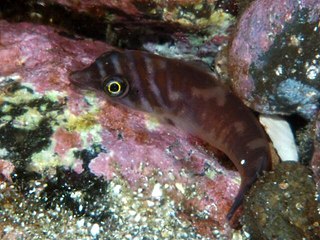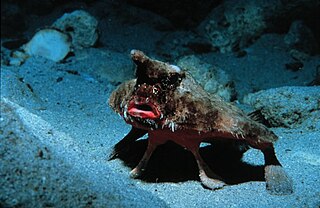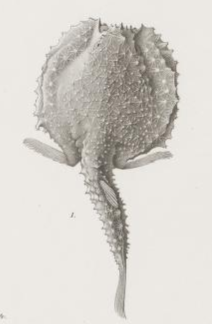
The snailfishes or sea snails, are a family of marine ray-finned fishes. These fishes make up the Liparidae, a family classified within the order Scorpaeniformes.

Clingfishes are ray-finned fishes of the family Gobiesocidae, the only family in the suborder Gobiesocoidei of the order Blenniiformes. These fairly small to very small fishes are widespread in tropical and temperate regions, mostly near the coast, but a few species live in deeper seas or fresh water. Most species shelter in shallow reefs or seagrass beds, clinging to rocks, algae and seagrass leaves with their sucking disc, a structure on their chest.

The Kerguelen petrel is a small slate-grey seabird in the family Procellariidae. It is the only species placed in the genus Aphrodroma. It is a pelagic, circumpolar seabird of the Southern Ocean. It breeds on islands in the southern Atlantic and Indian Oceans.

The sailfin tang, the Pacific sailfin tang, purple sailfinned tang or sailfin surgeonfish, is a marine ray-finned fish belonging to the family Acanthuridae which includes the surgeonfishes, unicornfishes and tangs. This fish is found in the Pacific Ocean and is popular in the aquarium hobby.

Ogcocephalus is a genus of marine ray-finned fishes belonging to the family Ogcocephalidae, the deep sea batfishes. The species in this genus are found in the Eastern Pacific Ocean and Western Atlantic Ocean, with most species in the eastern Atlantic Ocean where they live at shallower depths than the other ogcocephalid genera.

Paraliparis is a genus of fish in the family Liparidae, the snailfishes. It is found in benthic, benthopelagic and pelagic habitats in all the world's oceans.
Notoliparis is a genus of marine ray-finned fish belonging to the family Liparidae, the snailfishes. These fishes are found in deep Oceanic trenches in the South Atlantic South Pacific and Southern Oceans.

Careproctus is a genus of snailfishes found in benthic and benthopelagic habitats in the Atlantic, Pacific, Arctic and Southern Oceans. Whether they truly are absent from the Indian Ocean is unknown and might be an artifact of limited sampling. They range from shallow coastal seas in the far north of their range to the abyssal zone, at depths of 6 to 5,459 m (20–17,910 ft). In the Northern Hemisphere they mostly live shallower than Paraliparis, but this pattern is reversed in the Southern Hemisphere. Although almost entirely restricted to very cold waters, a single species, C. hyaleius, lives at hydrothermal vents.

Liparis fabricii, commonly known as the gelatinous seasnail or gelatinous snailfish, is a benthopelagic species of snailfish from the Arctic Ocean. It has a tadpole-like body with a maximum length of about 20 cm (7.9 in). It is brown to black in coloration with a distinctive dark peritoneum. It preys on small crustaceans and marine worms. It is not commercially important, though it is a valuable food source for predatory fish and seabirds in the Arctic region.

Gouania is a genus of clingfishes endemic to the Mediterranean Sea that contains at least 5 cryptobenthic species. The members of this genus are the only vertebrates to inhabit European intertidal gravel beaches and they have developed many adaptations to survive in this extremely harsh environment. They are a type of Clingfish meaning they form part of the family Gobiesocidae. All species of clingfish have a thoracic adhesive disc that allows them to hold on to both smooth and rough surfaces alike. This adaptation enables Gouania to survive the harsh conditions of gravel beaches, they are amongst the only fish taxa adapted to this habitat.

Lethotremus is a monospecific genus of marine ray-finned fish belonging to the family Cyclopteridae, the lumpfishes or lumpsuckers. This genus is found in the northern Pacific Ocean. Following a 2017 taxonomic review by Lee et al., the species Lethotremus awae was reclassified as a species of Eumicrotremus, leaving the genus monotypic with Lethotremus muticus as its only species. Also known as the docked snailfish, is a species of lumpfish native to the Northeast Pacific. It is known from the Bering Sea and the Aleutian Islands, where its range extends to Unimak Pass, and it occurs at a depth range of 58 to 330 m. It is a benthic species that reaches 11.5 cm in total length. It can be found on substrates of mud, rock, or gravel, and it is currently the only known species of Lethotremus, following a reclassification of the second described species in the genus as Eumicrotremus awae.
Allocareproctus is a genus of marine ray-finned fishes belonging to the family Liparidae, the snailfishes. These fish are found in the northern Pacific Ocean.

Elassodiscus is a genus of marine ray-finned fishes belonging to the family Liparidae, the snailfishes. These fishes are found in the Pacific Ocean.

Liparis marmoratus, or the festive snailfish, is a marine ray-finned fish from the genus Liparis. It was first described by Schmidt in 1950.

Niceforonia is a genus of frogs in the family Strabomantidae found in northern South America. The name refers to Nicéforo María, Colombian herpetologist.

Careproctus ovigerus, commonly known as the abyssal snailfish, is a species of snailfish found in the northeastern Pacific Ocean. It is found at depths of 1,920–2,910 m (6,300–9,550 ft) off northern British Columbia and off Washington state.

Paraliparis selti, the blue Atacama snailfish, is a species of deep water snailfish that is native to the south-east Pacific Ocean hadal zone 6,714 meters under water in the Atacama Trench. P. selti is 83 millimeters in length total and 75.9 millimeters in standard length. its one of the 200 species of snailfish discovered in the southern hemisphere.

Halieutopsis tumifrons,the truncate-snout deepsea batfish, is a species of marine ray-finned fish belonging to the family Ogcocephalidae, the deep-sea batfishes. This species is the type species of the genus Halieutopsis. It is a little known species only known from the two type specimens collected off the Galápagos Islands in 1890.
Elassodiscus caudatus, the blackbelly snailfish, is a species of snailfish. It is found in the Eastern Pacific from the eastern Bering Sea and southeastern Alaska to Monterey Bay, California.

James Wilder Orr is an American fisheries biologist, ichthyologist, and systematist best known for his studies of skates, rockfishes, snailfishes, and flatfishes. He has described 32 new species and two new genera of fishes, and is the author or co-author of more than 130 scientific and popular articles, including three books. His work has focused primarily on the phylogenetic relationships, zoogeography, reproductive biology, and behavior of marine teleosts, particularly deep-water benthic taxa. He has spent most of his career at the Alaska Fisheries Science Center, National Marine Fisheries Service (NMFS), in Seattle, as a Research Fisheries Biologist. At the same time, he has served as an Affiliate Professor at the School of Aquatic and Fishery Sciences, and Affiliate Curator of Fishes at the Burke Museum of Natural History and Culture, University of Washington, Seattle. For his lifetime of service, Orr was presented with a National Oceanic and Atmospheric Administration (NOAA) Distinguished Career Award in 2022.
















